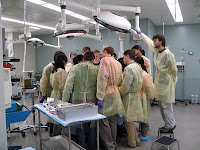Surgery for engineers

I was given the unique chance to take the Surgery for Engineers course this summer at Hopkins. As the official brochure says, it gives “orientation to undergraduate and graduate engineering students to basics of surgery to enable them to more effectively engage in engineering problem solving for current and future technologies. This course will not make engineers into surgeons, but will orient engineers to the operating room environment, sterile technique, equipment, laparoscopic, robotic, and 'open' instruments, basic surgical exposure and skills, and region specific fundamentals for specific targeted organ systems, as the liver, lungs, GI tract, pancreas, adrenal glands, kidneys, etc. “
This summer training consists of 6 4-hour-long classes in the medical school (in the Center for Minimally Invasive Technologies within) with joint practical sessions. The first day was more introductory, presenting the facilities and history of the Hopkins Hospital. It was founded in 1889, and by today it’s one of the biggest hospitals in the state. (They add a new block every year, and handled 400.000 inpatient days in 2007.) They have been selected for the No.1. hospital by the U.S.News & World Report journal in the past 17 years consecutively. They have received 14 Nobel prices in total. The second occasion was about suturing. We learnt about cutlery, electric knives and their use, and then how to tie a square knot, a surgeon knot, one and two handed. Later we had the opportunity to practice on pig legs. First we had to preparate some vessels or other structures, and then do the tying.
The consecutive class was about the abdomen. Basic anatomy, placement of incision, operating approaches and the preparation of gastro-intestinal (GI) anasthamoses. We were introduced to the linear and circular staplers that helps to faster stitch the tissues. In the OR, we had a pig in anesthesia to practice on. We had to open, fix and examine the abdomen, look for the different tissues, identify organs. Then we preformed a few side-to-side anatsthamoses on its small intestine, and later a gastric bypass. Another group was ultra-sounding the arteria carotis in the mean time. Finally, we closed the abdomen to practice the skills learnt the previous day.
This summer training consists of 6 4-hour-long classes in the medical school (in the Center for Minimally Invasive Technologies within) with joint practical sessions. The first day was more introductory, presenting the facilities and history of the Hopkins Hospital. It was founded in 1889, and by today it’s one of the biggest hospitals in the state. (They add a new block every year, and handled 400.000 inpatient days in 2007.) They have been selected for the No.1. hospital by the U.S.News & World Report journal in the past 17 years consecutively. They have received 14 Nobel prices in total. The second occasion was about suturing. We learnt about cutlery, electric knives and their use, and then how to tie a square knot, a surgeon knot, one and two handed. Later we had the opportunity to practice on pig legs. First we had to preparate some vessels or other structures, and then do the tying.
The consecutive class was about the abdomen. Basic anatomy, placement of incision, operating approaches and the preparation of gastro-intestinal (GI) anasthamoses. We were introduced to the linear and circular staplers that helps to faster stitch the tissues. In the OR, we had a pig in anesthesia to practice on. We had to open, fix and examine the abdomen, look for the different tissues, identify organs. Then we preformed a few side-to-side anatsthamoses on its small intestine, and later a gastric bypass. Another group was ultra-sounding the arteria carotis in the mean time. Finally, we closed the abdomen to practice the skills learnt the previous day.


Comments